#sambar masala
Explore tagged Tumblr posts
Text

Red Bell Pepper Tomato Chutney (Vegan)
#vegan#dips#chutney#indian cuisine#bell peppers#tomatoes#garlic#red onion#peanuts#mustard seeds#curry leaves#chili#sambar masala#avocado oil#🧡
61 notes
·
View notes
Text
Understanding the Different Types of Masala: From Garam Masala to Chaat Masala

Masalas are the cornerstone of Indian cuisine, infusing dishes with rich flavours and aromas that are simply unmatched. With a wide variety of masala blends available, each with its unique taste and purpose, it can be helpful to understand the different types of masala and how they are used in cooking. In this blog, we’ll explore popular masala varieties like Garam Masala and Chaat Masala, along with their differences and flavour profiles.
1. Garam Masala:
Garam Masala is perhaps one of the most well-known and widely used Indian spice blends. The term “garam” means “warm” or “hot” in Hindi, which reflects the warming qualities of this masala. Typically made by grinding together a mix of spices like cumin, coriander, cardamom, cloves, cinnamon, and black pepper, Garam Masala adds a deep, aromatic flavour to dishes.
Used in a variety of recipes, from curries to soups, Garam Masala is often added towards the end of the cooking process to preserve its delicate flavours. It’s an essential part of many Indian households and is considered a versatile masala that can elevate almost any dish.
2. Chaat Masala:
In contrast to Garam Masala, Chaat Masala offers a tangy, zesty flavour that’s often used as a finishing spice. It’s a key ingredient in popular Indian street foods like chaat, salads, and fruits. The unique taste of Chaat Masala comes from the combination of spices like dried mango powder (amchur), black salt, cumin, coriander, and asafoetida.
This masala is often sprinkled over snacks to give them a tangy kick and is also used in beverages like buttermilk and lemonade. Chaat Masala is a great way to add a burst of flavour to your dishes with minimal effort.
3. Understanding the Differences:
While both Garam Masala and Chaat Masala are essential in Indian cooking, they serve very different purposes. Garam Masala is a warm, robust blend used mainly during cooking to enhance the depth of flavours in a dish. It complements rich, hearty dishes like curries, stews, and meat-based recipes.
On the other hand, Chaat Masala is a tangy, finishing spice used primarily for garnishing. It adds a punchy, sour flavour to lighter dishes like salads, fruits, and snacks. Understanding these masala differences helps in choosing the right spice blend for your culinary creations.
4. Other Popular Masala Varieties
India’s culinary landscape is vast, with countless masala varieties catering to different regional tastes and cooking styles.
Here are a few other popular masala types:
–Curry Masala: A blend of spices typically used in making curries. It includes turmeric, cumin, coriander, and fenugreek, among others.
-Tandoori Masala: A smoky, spicy blend used in tandoor-cooked dishes like tandoori chicken. It includes cayenne pepper, paprika, and garlic powder.
–Sambar Masala: A South Indian blend used in making sambar, a lentil-based vegetable stew. It includes mustard seeds, fenugreek, dried red chilies, and curry leaves.
Each of these masala blends brings its own unique flavour profile to the table, making Indian cuisine rich and diverse.
Conclusion
The world of masalas is as diverse as it is flavorful. From the warm, aromatic notes of Garam Masala to the tangy zest of Chaat Masala, each blend serves a unique purpose in the kitchen. Understanding the differences between these masalas not only enhances your cooking but also deepens your appreciation for the art of Indian cuisine. Whether you’re preparing a rich curry or a light salad, choosing the right masala can make all the difference in your dish.
Source : https://www.kbmfoods.com/understanding-the-different-types-of-masala-from-garam-masala-to-chaat-masala/
0 notes
Text
Delicious Sambar Masala Recipe with Suhana Sambar Masala
Do you know about the origins of Sambar? This lentil-based stew prepared with vegetables, tamarind, and spices was introduced in Tamil Nadu during the Marathi reign in Tanjore and can be found throughout South India. Having a tangy and savoury taste, sambar goes well with rice, dosa, idli, upma, vada, etc. It’s rich in protein, and you can have it for breakfast, lunch, and dinner, making you feel satiated. You can make an authentic sambar with the right spices at home. If you can’t, here’s an easy way to make sambar – through Suhana Masala. Here’s how you can make traditional South Indian sambar at home easily!
How do you make a sambar using the traditional South Indian method?
List of the ingredients needed for making authentic sambar
Here’s what you need to make sambar:
Toor dal – 1 cup
Vegetables of your choice – shallots, drumstick, potato, capsicum, broad beans, ladies finger, cut into broad pieces (you can add any one of these with shallots to make sambar)
Tamarind pulp – 1 cup (soak a lemon-sized tamarind in hot water and extract the pulp)
Suhana sambar masala – 2 tablespoons
Oil, mustard seeds, hing, dry red chillies, and curry leaves for tempering.
Water and salt as required
Jaggery – 1 tablespoon (optional)
Coriander leaves (optional)
Step-by-step sambar recipe with Suhana sambar masala
Add toor dal and vegetables of your choice to a pressure cooker and cook for four to five whistles.
Meanwhile, peel the shallots. In a kadhai, add oil and fry the shallots. Once cooked, add the tamarind pulp and let it cook for some time until the shallots become soft. Ensure to cook this on simmer mode. If you do this on high flame, the tamarind pulp may become thick in no time, and it might affect the taste of your sambar.
Once your toor dal and vegetables are cooked, add the mashed lentils and vegetables to the tamarind pulp and shallots mix, with Suhana sambar powder and jaggery, with salt and let it boil for 10 minutes.
You can also cook the vegetables directly in the tamarind pulp, but this may take a while. So, if you are on a time crunch, just use a pressure cooker!
Add water if your sambar is thick. If not, add oil and mustard seeds in a small frying pan. After they splutter, add hing, curry leaves and dry red chilly. Add this to your sambar and turn the stove off.
Authentic South Indian sambar is ready with a Suhana mix in no time!
Serving Suggestions
Serve it hot with rice, idli, or dosa. If eaten with rice, adding ghee or sesame oil may enhance the sambar taste! You can garnish with coriander leaves before serving. However, it’s entirely your choice, as the taste does not alter with coriander, but this will give off a wafting aroma!
Health benefits of spices and herbs used in Suhana sambar masala
Suhana sambar masala has no added preservatives or MSG, making it completely safe to consume. Turmeric in the masala acts against inflammation in the body and reduces infections and allergic reactions. Cumin and fenugreek aid in digestion, regulate blood sugar levels and promote healthy blood circulation. You can add sambar to your daily diet, and it’s highly nutritional. Protein-packed lentils and vegetables like shallots will help your body cool down during summer!
Here’s to making delicious sambar at home with Suhana! You can get this from our website.
FAQs
Can I use other types of lentils instead of toor dal?
You can also add moong dal to sambar, but this may alter the taste of sambar a bit. Or you can use both, depending on your choice!
Is it necessary to use tamarind pulp, or can I substitute it with something else?
Tamarind pulp is necessary to make sambar. If you don’t use tamarind, add local tomatoes instead of apple tomatoes for a tangy flavour.
What vegetables can I add to the sambar?
To your sambar, add potato, drumstick, raw mango, broad beans, carrot, capsicum, radish, pumpkin (white and red), and shallots.
0 notes
Text
Buy Sambar Masala Powder Online
Kichnam Sambhar Masala Powder is a blend of authentic spices for a flavor-packed Idli Sambhar meal that will enhance the taste and make you feel like a truly South Indian Dish.
0 notes
Text
Make Every Bite Count at Kuppanna’s Unlimited Dosa Night

Are you a dosa enthusiast? If crispy, golden dosas with a variety of chutneys and sambar make your heart skip a beat, then Kuppanna’s Unlimited Dosa Night is where you need to be!
Why Choose Kuppanna’s Unlimited Dosa Night?
Diverse Dosa DelightsFrom the classic plain dosa to flavorful masala dosa, every bite is crafted to perfection. Our chefs ensure that each dosa is crispy on the outside and soft on the inside, bursting with authentic South Indian flavors.
Unlimited Sambar and ChutneysPair your dosas with our freshly made coconut chutney, tomato chutney, and piping-hot sambar. Refills are endless, ensuring your taste buds are never left wanting.
Perfect for Families and FoodiesWhether you’re dining with family or friends, our Unlimited Dosa Night offers something for everyone. It’s the perfect opportunity to bond over food and create memories.
Exceptional AmbianceEnjoy a warm and welcoming atmosphere, ideal for a relaxed evening. Our friendly staff ensures that your dining experience is seamless and satisfying.
When to Join Us
Our Unlimited Dosa Night happens every Wednesday, from 6:30 PM to 10:00 PM, exclusively for dine-in guests.
Don’t Miss Out!
Satisfy your cravings and indulge in the best dosa experience in town. Visit Kuppanna this Wednesday for an unforgettable Dosa Night.
Call us now to reserve your table!
#unlimited dosa night#Kuppanna Austin#indian food near me#best indian dish#masala dosa and plain dosa#sambar#chutneys
1 note
·
View note
Text
Discover the Essence of Authentic South Indian Flavor with Chotus Foods
When it comes to South Indian cuisine, few dishes hold the iconic status that sambar does. This hearty, tangy, and flavorful lentil-based stew, packed with vegetables and aromatic spices, is a staple in households and restaurants alike. But preparing sambar from scratch can sometimes feel overwhelming, especially when balancing the perfect mix of spices. That’s where Chotus Foods steps in to make your culinary journey effortless and delicious with their Sambar Masala Powder, Instant Sambar Mix, and the promise of delivering the best sambar masala on the market.

Whether you’re a novice cook or a seasoned chef, Chotus Foods ensures that preparing sambar becomes a joy rather than a chore.
The Magic of Sambar: A South Indian Treasure
Sambar is more than just food; it’s an emotion, a comfort, and a cultural icon. Traditionally, sambar is made using a delicate balance of lentils, tamarind, and an assortment of spices. The flavor profile of this dish is as complex as it is delightful—earthy, tangy, spicy, and slightly sweet.
However, achieving that authentic taste requires a precise combination of spices like coriander, fenugreek, mustard seeds, and curry leaves, along with perfectly cooked vegetables and lentils. This is where the genius of sambar masala powder comes into play.
Why Sambar Masala Powder is a Game-Changer
Crafting sambar from scratch involves grinding and roasting a variety of spices, which can be time-consuming and daunting. A quality sambar masala powder like the one from Chotus Foods simplifies the process by providing a perfectly blended mix of spices.
Here’s why you need to incorporate it into your kitchen routine:
Authentic Taste in Seconds Chotus Foods’ sambar masala powder is crafted to replicate the traditional recipe, delivering the same authentic South Indian flavor with every use.
Consistency Guaranteed Unlike homemade blends that can vary in taste, the sambar masala powder ensures a consistent flavor every single time.
Time-Saving Convenience With a pre-made masala, you can skip the tedious process of measuring and roasting spices, making sambar preparation quicker and easier.
High-Quality Ingredients Chotus Foods takes pride in using the finest ingredients to create their masala powders, ensuring every bite of sambar is rich in flavor and health benefits.
Instant Sambar Mix: A Busy Cook’s Best Friend
For those days when you’re pressed for time but crave a comforting bowl of sambar, Chotus Foods’ Instant Sambar Mix comes to the rescue. With minimal effort, you can have a pot of steaming hot sambar ready to serve, without compromising on taste or authenticity.
What Makes the Instant Sambar Mix Stand Out?
Quick and Easy Preparation Forget long hours in the kitchen. With the instant mix, all you need to do is add water, vegetables, and cook.
Perfectly Balanced Flavor The mix contains all the essential spices in just the right proportions, so you never have to second-guess your seasoning.
Versatility The instant sambar mix can also be used as a base for innovative dishes like sambar rice or even lentil-based soups.
No Compromises on Quality Chotus Foods ensures that the instant mix is free from artificial preservatives or additives, making it a healthier choice for your family.
What Makes Chotus Foods’ Sambar Masala the Best?

When it comes to masalas, the market is flooded with options. So, what sets Chotus Foods’ Sambar Masala Powder apart? It’s a combination of:
Expert Craftsmanship The blend is created by culinary experts who understand the delicate nuances of South Indian flavors.
Freshness Sealed Every batch of sambar masala powder is sealed to preserve its freshness and aroma, so you get the best flavor every time you open the pack.
Health Benefits The carefully selected spices in the masala not only enhance the taste but also offer numerous health benefits. Turmeric, for instance, is known for its anti-inflammatory properties, while fenugreek aids digestion.
Versatile Usage While it’s perfect for sambar, the masala can also be used in other dishes like rasam, lentil stews, or even vegetable stir-fries.
Tips for Making the Perfect Sambar
Even with the Best Sambar Masala powder or instant mix, a few tricks can take your sambar to the next level.
Choose the Right Vegetables Classic sambar recipes often include drumsticks, carrots, radishes, tomatoes, and okra. Experiment with your favorite veggies for a personalized touch.
Cook Lentils Thoroughly Ensure that your lentils are soft and creamy before adding them to the sambar. A pressure cooker can help speed up the process.
Tamarind for Tanginess Tamarind pulp adds the essential tanginess to sambar. Use fresh tamarind or tamarind paste for the best results.
Don’t Skip the Tempering A final tempering of mustard seeds, curry leaves, and dried red chilies in hot oil can elevate the flavor of your sambar.
Let It Rest Allow the sambar to sit for a few minutes after cooking. This helps the flavors meld beautifully.
Innovative Ways to Enjoy Sambar
Sambar isn’t just for pairing with rice or idlis. Here are some fun and creative ways to incorporate it into your meals:
Sambar Pasta Toss cooked pasta in sambar for a fusion dish that’s tangy, spicy, and delicious.
Sambar Soup Add extra water to your sambar to create a comforting soup, perfect for chilly evenings.
Sambar Pizza Use sambar as a base sauce on pizza for a South Indian twist on this Italian favorite.
Sambar Fried Rice Mix leftover sambar with rice and sautéed vegetables for a quick and flavorful fried rice.
Why Choose Chotus Foods for Your Sambar Needs?
Chotus Foods is committed to delivering products that simplify your cooking while maintaining authentic flavors. Whether it’s their sambar masala powder, instant sambar mix, or other spice blends, you can trust their expertise to elevate your meals.
Customer Testimonials
“The sambar masala powder from Chotus Foods is a lifesaver! It has made my cooking so much easier, and the flavor is unbeatable.”
“I love the instant sambar mix. It’s perfect for my busy mornings when I want to prepare a quick and wholesome breakfast.”
Final Thoughts
Sambar is a dish that transcends boundaries, loved by people across India and beyond. With Chotus Foods’ Sambar Masala Powder, Instant Sambar Mix, and their dedication to quality, creating authentic sambar at home has never been easier.
So, the next time you crave that perfect bowl of sambar, reach for Chotus Foods. Let the aroma of freshly made sambar fill your home, and savor the taste of tradition made simple.
Explore the world of Chotus Foods today and redefine your cooking experience!
0 notes
Text
Sambar is a delicious South Indian dish made from lentils and vegetables. It is spicy and full of flavor. You can enjoy sambar in many ways by pairing it with different foods. Just buy sambar masala to make these ten great options to make your meal tasty and enjoyable
0 notes
Text
Health Benefits of Using Sambhar Masala in Your Cooking
In the rich tapestry of Indian cuisine, Sambhar Masala stands out as a vibrant and aromatic blend of spices, revered not only for its flavor but also for its myriad health benefits. Derived from traditional recipes passed down through generations, this spice mix has found its way into kitchens around the world, adding depth and complexity to dishes while offering a treasure trove of wellness properties.
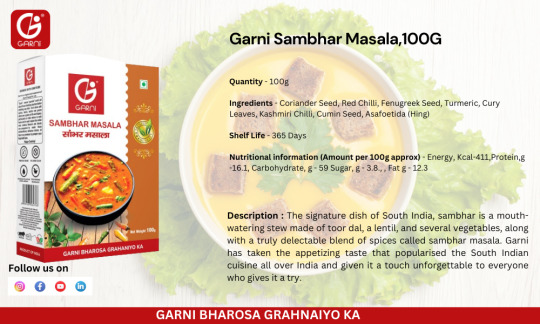
Introduction to Sambhar Masala
Sambhar Masala, often referred to as sambar masala powder, is a quintessential component of South Indian cooking, particularly in the preparation of Sambhar, a lentil-based stew that is a staple in many households. This fragrant blend typically includes spices such as turmeric, coriander, cumin, fenugreek, and more, each contributing its unique flavor profile and health-promoting properties.
Nutritional Profile
The nutritional value sambhar masala 100g is impressive, owing to the diverse array of spices it contains. Turmeric, a key ingredient, boasts potent anti-inflammatory and antioxidant properties, while coriander and cumin offer essential vitamins and minerals. Fenugreek, another staple spice, is known for its digestive benefits, making Sambhar Masala not just a flavor enhancer but a nutritional powerhouse.
Anti-inflammatory Properties
One of the most notable health benefits of Sambhar Masala stems from the anti-inflammatory properties of its ingredients, particularly curcumin found in turmeric. This compound has been studied extensively for its potential to alleviate inflammation in the body, offering relief from conditions such as arthritis and inflammatory bowel diseases.
Digestive Benefits
The digestive system also stands to gain from the inclusion of Sambhar Masala in cooking. Cumin, fenugreek, and other spices in the blend have long been used in traditional medicine to promote digestion and alleviate gastrointestinal discomfort. Incorporating Sambhar Masala into your dishes may help support overall digestive health and ease digestive woes.
Immune-Boosting Properties
The immune system receives a boost from the antioxidant-rich spices in Sambhar Masala. Turmeric and coriander, in particular, contain compounds that help combat oxidative stress and bolster immune function, potentially reducing the risk of infections and supporting overall health and well-being.
Potential Weight Management Benefits
For those on a weight management journey, Sambhar Masala can be a valuable ally. The spices it contains, such as turmeric and cumin, have been linked to improved metabolism and increased feelings of fullness, which may aid in weight loss and weight maintenance efforts.
Heart Health
Maintaining cardiovascular health is crucial for overall wellness, and Sambhar Masala can play a role in this regard. Certain spices in the blend, like coriander and fenugreek, have been shown to have beneficial effects on heart health by helping to lower cholesterol levels and regulate blood pressure.
Blood Sugar Regulation
Individuals concerned about blood sugar levels can also benefit from using Sambhar Masala in their cooking. Fenugreek, a common ingredient in the blend, has been studied for its potential to improve insulin sensitivity and regulate blood glucose levels, making it a valuable addition to diabetic-friendly recipes.
Antimicrobial Properties
In addition to its culinary and wellness benefits, Sambhar Masala also possesses antimicrobial properties that help fight off harmful bacteria and pathogens. This can contribute to better overall health and a reduced risk of foodborne illnesses.
Tips for Incorporating Sambhar Masala into Cooking
Now that we've explored the numerous health benefits of Sambhar Masala, let's discuss some practical tips for incorporating this versatile spice blend into your cooking. From traditional Sambhar recipes to innovative fusion dishes, the possibilities are endless when it comes to using Sambhar Masala in the kitchen.
Whether you're preparing a comforting lentil stew, a fragrant vegetable curry, or a spicy stir-fry, Sambhar Masala adds depth, complexity, and a burst of flavor to any dish. And with Garni Foods offering high-quality Sambhar Masala in convenient packaging, you can easily buy Sambhar Masala online and elevate your culinary creations with ease.
Conclusion
In conclusion, the health benefits of using Sambhar Masala in your cooking are undeniable. From its anti-inflammatory and digestive properties to its immune-boosting and heart-healthy effects, this aromatic spice blend offers a myriad of reasons to incorporate it into your daily meals. So why wait? Spice up your dishes and nourish your body with the goodness of Sambhar Masala today.
#sambhar masala#sambar masala powder#buy sambhar masala#buy sambhar masala online#sambhar masala 100g
0 notes
Text

Craving delicious Sambar? Find the perfect blend of spices online at the best price! Order Online Sambar Masala now and have an authentic South Indian taste delivered to your doorstep.
0 notes
Text
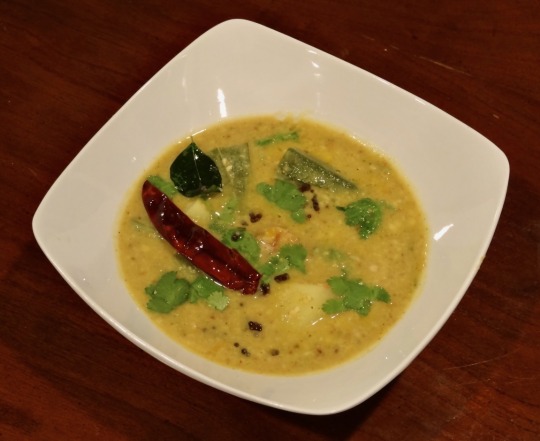
[ID: A bowl of a bright yellow stew topped with cilantro, mustard seed, chili, and curry leaf. End ID]
ಉಡುಪಿ ಸಾಂಬಾರ್ / Udupi sambar
A sambar is a lentil-and-vegetable stew distinguished by the use of a particular spice blend (Hindi: सांबर मसाला "sāmbār masālā," "sambar spice"; Kannada: ಸಾಂಬಾರ್ ಪುಡಿ "sāmbār puḍi," "sambar powder"). Sambars are a staple of South Indian and Sri Lankan cooking, sometimes made in households for multiple meals a week. The word "sambar" can be traced back to the Sanskrit सम्भार "sambhārá," "collection of things required for a particular purpose”; “spices."
The lentil used in sambar dishes is usually tur dal (split pigeon peas), though arhar dal, tuvur dal, or even blends containing masur or mung dal may be used, depending on the cook or the region. Vegetables also vary between combinations of okra, potato, ash gourd (petha), bottle gourd (doodhi / lauki), drumstick (saijan ki phalli), beetroot, tomato, carrot, pumpkin, brinjal, and pearl onions, among others. The sambar masala fries chilis, curry leaves, dal, and various spices including cumin, coriander, and fenugreek, then grinds them into a spicy, earthy, fragrant blend.
This recipe makes a sambar in the style of ಉಡುಪಿ (Udupi) cuisine—a subdivision of the cuisine of the ತುಳುವ (Tuluva) people localised in the Udupi District of Karnataka, a southeastern coastal state of India. (Tuluva cuisine is also commonly found in Dakshina Kannada, Karnataka, and Kasaragod, Kerala). In the Udupi region, sambar may be known as "ಕೊಡೆಲ್" "kodhel"; perhaps related to "ಕಡಲೆ" "kadhale" "Bengal gram"; or "ಹುಲಿ" "huḷi"; "tartness." Udupi huli has coconut oil and jaggery as its primary distinguishing features: the jaggery's deep sweetness and the earthy pungency of unrefined coconut oil combine with the spice of the chilis and the sour fruitiness of the tamarind to create a complex, flavorful, well-balanced dish.
Udupi huli may be further divided into a few major types. ಮಸಾಲೆ ಹುಳಿ ("masāla huḷi") contains shredded coconut and vegetables; ಬೋಳು ಹುಳಿ ("bolu huḷi") contains vegetables, but omits the coconut.
Hotel-style masala huli recipes typically add a lot of jaggery to produce a distinct sweetness; cut back on the amount of coconut included; and contain onion and garlic. The other main type of masala huli—“temple style”—is sattvic (from Sanskrit "सत्त्व" "sattva": "goodness," "essence," "existence"), which in this context means that onions and garlic are excluded.
A sattvic diet in Hinduism centres around the concept of maintaining sattva by eating only pure and mild (sattvic) foods, and omitting tamasic (“dark,” "inert," "destructive"; from Sanskrit तमस् "tamas") and rajasic ("exciting," "passionate," from Sanskrit रजस् "rajas") ones. The concepts of sattva, tamas, and rajas (the गुण "guṇa" system) are central to the construction of caste: the degree to which each person innately inherits each quality supposedly determines their possession of characteristics including honesty, intelligence, and goodness (sattva), stupidity and lack of creativity (tamas), and passion and pridefulness (rajas); the possession of these characteristics in turn determines their rightful place in a professional and social hierarchy. The association of certain foods with certain qualities thus links diet to caste: a distinction in diet is one of the methods by which those belonging to upper castes maintain and police caste boundaries.
This recipe makes enough pudi for one pot of sambar. Traditionally, sambar pudi is created fresh each time the dish is made, but many households make large batches and store them. In this case, omit the coconut; or, use dried coconut and store the masala in the refrigerator.
Recipe under the cut!
Patreon | Paypal | Venmo
Ingredients:
Serves 4-6.
For the sambar:
2 cups chopped vegetables
1 red onion, sliced*
1 cup (200g) yellow split pigeon peas / tur dal / ತೂರ್ ದಾಲ್ (ಹಳದಿ ಸ್ಪ್ಲಿಟ್ ಪಾರಿವಾಳದ ಬಟಾಣಿ)
4 cups (1 litre) water, or as needed
1/4 tsp ground turmeric / haldi / ಅರಿಶಿನ
2 tsp table salt
2 tsp jaggery / gur / ಬೆಲ್ಲ*
1/4 cup (60mL) tamarind pulp (from 1 Tbsp dried tamarind / imlie / ಹುಣಸೆಹಣ್ಣು)
2 tsp unrefined coconut oil / nariyal ka tel / ತೆಂಗಿನ ಎಣ್ಣೆ
Ingredient list format is English / Hindi (Latin transcription) / Kannada. The Hindi is provided for convenience while shopping.
Udupi sambar usually uses any of: gourd, brinjal (Indian eggplant), pumpkin, dumstick (saijan ki phalli), and okra. Pearl onion is not usually used in this region, but you can add whatever you want, according to taste.
*For a hotel-style sambar, include the onion; increase the jaggery to 2 Tbsp.
For the spice paste / sambar masala / ಸಾಂಬಾರ್ ಪುಡಿ ("sambar pudi"):
1/2 Tbsp split Bengal gram / chana dal / ಹಳದಿ ಸ್ಪ್ಲಿಟ್ ಗ್ರಾಂ
2 tsp split black gram / urad dal chilka / ಸ್ಪ್ಲಿಟ್ ಬ್ಲ್ಯಾಕ್ ಗ್ರಾಂ
2 tsp coriander seeds / dhaniya / ಕೊತ್ತಂಬರಿ ಬೀಜದ
1/2 tsp fenugreek seeds / methi / ಮೆಂತ್ಯ
1 tsp cumin seeds / jeera / ಜೀರಿಗೆ
1 tsp ground turmeric
5-6 curry leaves / kari pati / ಕರಿಬೇವು
3-4 Byadagi or other dried red chilis / byadagi mirch / ಬ್ಯಾಡಗಿ ಮೆಣಸಿನಕಾಯಿ
4 cloves garlic, skins on*
Large pinch asafoetida / hing / ಇಂಗು
1 cup (100g) fresh coconut (about one coconut)*
1/2 cup (120mL) water
While the ratio of ingredients in Udupi sambar pudi vary slightly, the ingredients themselves are almost always consistent.
*For a hotel-style sambar, include the garlic, and decrease the coconut in the sambar masala to 1/4 or 1/2 cup (25-50g).
The grams and pulses in this pudi have many different names. You can find them in a halal or South Asian grocery store; look on the bag for the Hindi names (since they have been transcribed into Latin, the spelling may vary from what you see here).
The urad dal you find may be husked, and thus yellow instead of black; these will work just as well.
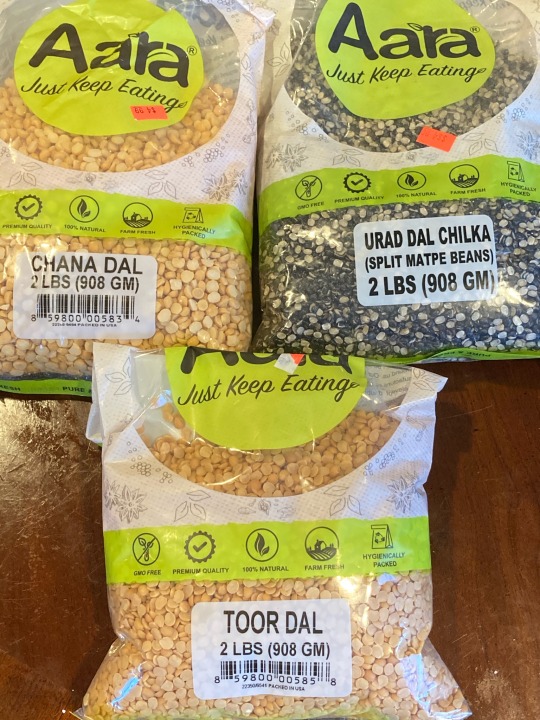
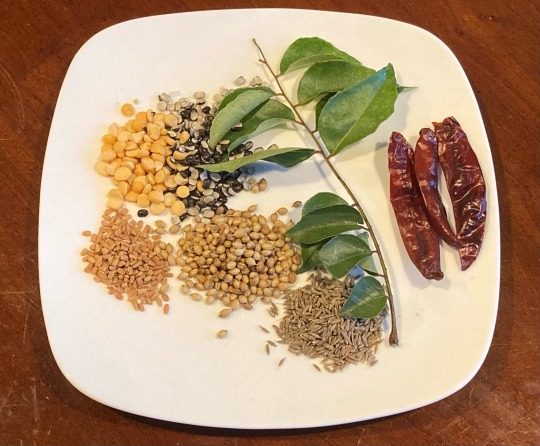
For the tempering / tadka / ಹದಗೊಳಿಸುವ:
2 Tbsp unrefined coconut oil
2 red chilis
8 curry leaves
1 tsp brown mustard seeds / rai / ಸಾಸಿವೆ ಬೀಜಗಳು
Recipes from north Karnataka may add cumin and whole, unpeeled garlic cloves to the tempering.
Instructions:
For the sambar pudi:
1. Break open the coconut and remove and shread its flesh.
If using a whole dried coconut, break into the shell with the wrong side of a hammer and pry open. Break into a few smaller pieces and peel with a vegetable peeler until the skin is removed from the white flesh, wearing something to protect your hand. Soak in warm water for several minutes to soften, and then grate or food process.
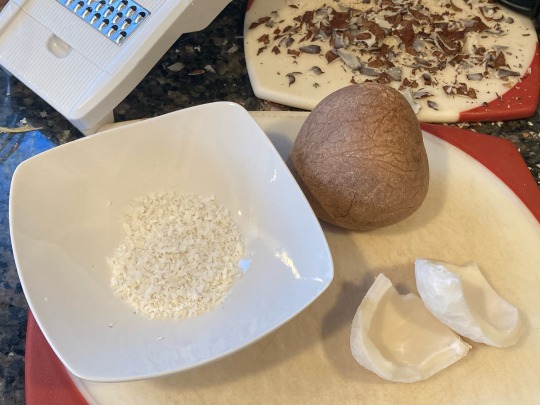
2. Heat 2 Tbsp of coconut oil in a skillet on medium-low. Add asafoetida and fry for 30 seconds, until no longer raw-smelling. Add dal and fry, stirring often, for 30 seconds until golden brown; add coriander, mustard, fenugreek, and cumin seeds and fry until fragrant.
3. Add curry leaves and fry until wilted, then add garlic and dried chilis and fry another 30 seconds to a minute, until fragrant.
4. Add coconut and fry, stirring often, for another few minutes until a shade darker. Add turmeric and stir.
5. Grind all ingredients into a paste in a mortar and pestle, then mix in about 1/2 cup water to loosen (if using dried coconut, you may need more water).
Or, put all ingredients along with 1/2 cup water into a blender or food processor and process until a relatively smooth paste forms.
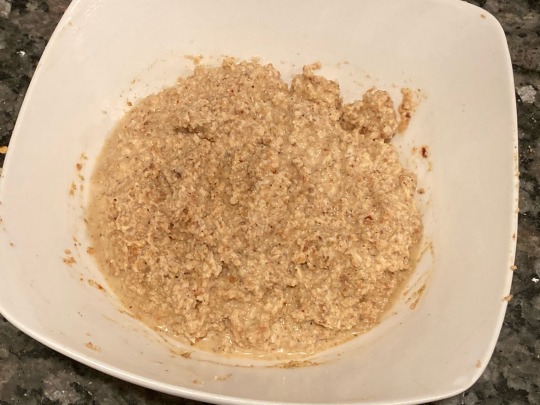
For the sambar:
1. Wash tur dal to remove excess starch. Simmer dal with 2 cups water, 1/4 tsp ground turmeric, and 1 tsp coconut oil for about 30 minutes until very tender. Mash until relatively smooth with a wooden spoon or bean masher, or process briefly with an immersion blender.
You may soak the dal in water after rinsing them to reduce the cooking time, but it is not necessary.
2. Meanwhile, make the tamarind paste. Soak 1 Tbsp tamarind dried pulp in 1/4 cup hot water for 20-30 minutes. Squeeze the tamarind into the water to extract the pulp. Discard the tamarind seeds and husk. Optionally, depending on your preferred texture, push the mixture through a metal sieve.
3. Prepare vegetables. Slice the onion; remove ends of okra and drumsticks and cut into 2-inch pieces; quarter tomatoes; quarter brinjal; peel pumpkin and cut into cubes; peel and cube potatoes.
4. If using onion, add a teaspoon of coconut oil to a large pot and fry until translucent.
5. In the same pot, boil vegetables in just enough water to cover, along with a pinch of salt, until they are beginning to soften.
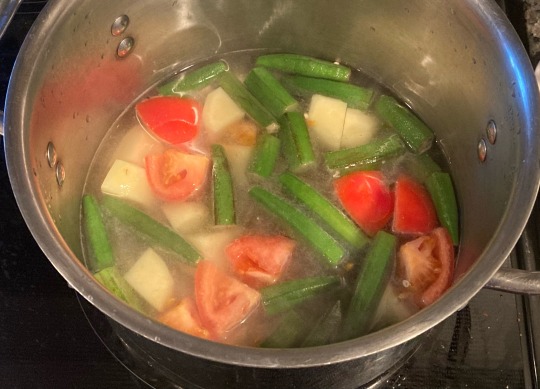
Some recipes call for the vegetables to be boiled, and others call for them to be steamed. I prefer boiling, since it produces a nice savory broth.
6. Mix vegetables, dal, tamarind, jaggery, sambar pudi, and salt to taste and simmer 5-10 minutes to allow flavors to combine and vegetables to cook under tender. Add water as needed. Remove from heat and stir in cilantro. Taste and adjust salt.
The final sambar should be pourable, like a thick soup—Karnataka sambar is typically thinner in consistency than Tamil Nadu versions.
For the tadka:
1. Heat coconut oil in a small skillet on medium heat. Add tempering ingredients and fry, stirring often, until chilis and curry leaves are a couple shades darker and the mixture is fragrant.
2. Pour the oil and tempering ingredients into the sambar and stir in. If you like, retain some of the tadka as a garnish to serve.
3. Serve warm, in individual bowls, alongside long-grain white rice. To eat drumsticks, scoop the center out and eat it; the tough outer rind is left.
If you intend to save some sambar, it's a good idea to make just enough tadka for what you plan to eat that day, and then make fresh tadka to pour over the reheated leftovers.
112 notes
·
View notes
Text

Masala Dosa served with a crunchy Vada and spicy sambar and chutney... yummy 😋
#food#food photography#foodie#foodgasm#foodmyheart#foodlover#foodporn#foodpics#healthy food#comfort food#south indian food#dosa#masala dosa#indiancuisine#india#south indian dishes
10 notes
·
View notes
Text
youtube
Craving a comforting South Indian meal? Watch how to make a delicious bowl of Sambar rice using homemade Sambar Masala by Adeetham, available on Tocco. This easy recipe brings the authentic taste of South India right to your kitchen. Perfect for a cozy meal!
#homemade#healthy eating#south indian sambar#sambar masala#sambar#sambar rice#sambar podi#sambar powder#bisi bele bath#Youtube
0 notes
Text
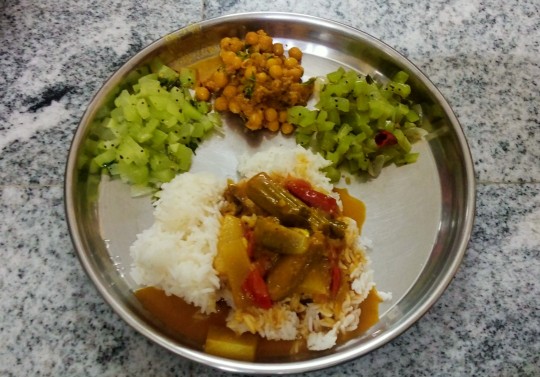
Vegan food plate
Day-20
*Mixed vegetable Sambar
*Peas masala
*Snake guard poriyal
*Chow chow poriyal
#tryingtobevegan #healthyplate #veganfood #buddingvegan #healthyfood #homemade #govegan #loveforfood #foodblog #enjoyfood #enjoyeating #enjoylife
17 notes
·
View notes
Text
I was tagged by @last-smoke, thank you!!
last song: Comfort Eagle by Cake
currently reading: Sisters in Hate by Seyward Darby
last movie: God's Own Country!!
currently watching: Critical Role when I'm doing repetitive crafts, Taskmaster when I need a mood boost
currently craving: sambar! chana masala! and I've got a hankering for veda soup (groundnut soup) as well
currently consuming: I've got some popped corn with nooch!
three ships: TOMJOHN, dorym, griddlehark. and a bonus merthur because I love them. special shoutout to Leliana/fem grey warden!
first ship: ohhhh it's been so long. but probably Oliza/Betia from the Kiesha'ra stories? that was the first where I remember thinking like "oh I wonder if anyone else is into this, I want to read more about it" and as I read the book it turns out they were canon yaaay
favorite color: purple! or blue. I love purple on other things. I love wearing blue!
currently working on: too many fiber arts projects. someday I will write again
i'm tagging 👀 @study-inscarlett @thebeautifulsoup @leastsaid @mrfutureboy @jordenspuls @thinkanamelater
13 notes
·
View notes
Note
If u were to make a choice between 1 & 2 ... which one would you pick?
1) curd rice mixed with sambar mixed with masala puri mixed with paneer butter masala ( background movie playin' jai simha)
2) chappathi with kurma mixed with sprite , jeera water & nannari sarbath.... ( background movie playin' vijayendra varma)
Guess who is this anon without any malpractice.... Hehehe.... JFF
2 cause it feels legal and also i can't guess who this is so I'll be expecting a msg from whoever this is😅
2 notes
·
View notes
Text
Required Information Sheet For The Human AU: Johnny
General Information:
Last Name: Taylor
First Name: Johnathan
Middle Name: Demarcus
Nickname(s): Johnny, Jahnu, Johns, John-song, Jay
Alternative Name(s): Jahnu Jiyaan Aarav Sutar and Kallik
Pronouns: He/They/His/Theirs
Gender Identity: Demiboy
Sexuality: Gay
Birthdate: January 29, 2004
Ethnicity: British Indian
Dietary Style: Vegetarian
Religious Affiliation: Hindu
Known Languages: English, Hindi, and ASL
Appearance Information
Hair Color Hex Code: #262626
Curl Texture: 3b
Eye Color Hex Code: #875B04
Skin Tone Hex Code: #574012
Beauty Mark(s): Small Scar on Right Cheek, Lip Piercing on Right Side, Eyebrow Piercing on Left Side, Body Tattoos
Glasses/Contacts: No
Height: 5’8.5”
Weight: 135 lbs
Build Type: Inverse Triangle
Clothing Aesthetic: Skater Boy and Light Grunge
Education Information:
Past Education: South Loop High School
Current Education: Gap Year
Career Information:
Past Employment: Skate Shop Employee
Current Job: Contracted Professional Actor and Singer
Dream Job: Professional Singer and Actor
Company: The New Moon Theatre Troupe
Current Employer: The Majestic Performing Arts Theatre
Extracurriculars: Volunteer at South Loop Animal Shelter and Mechanic Assistant at Taylor Family Garage
Parentage Information:
Biological Parent 1: Jia Saanvi Taylor ‘nee Sutar (Deceased)
Relation: Biological Mother
Relationship: Close
Pronouns: She/Her/Hers
Career: Primary School Music Teacher and Pianist
Birthdate: February 13, 1975
Biological Parent 2: Marcus Christian Taylor
Relation: Biological Father
Relationship: Close
Pronouns: He/Him/His
Career: Automotive Mechanic and Garage Owner
Birthdate: November 12, 1973
Foster Parent: Rosita Jazmín Peréz-Harrison
Relation: Foster Mother of 8 Months
Relationship: Close
Pronouns: She/Her/Hers
Career: Consulting Environmental Engineer
Birthdate: May 16, 1985
Sibling Information:
Sibling 1: Nooshy Victor Peart-Taylor
Relation: Adoptive Sister
Relationship: Close
Pronouns: She/They/Hers/Theirs
Education: Remedial Online High School
Birthdate: November 3, 2001
Assorted Information:
Best Friend(s): Meena Amari (since Sing 1) and Ryan Willis (roommate)
Favorite Color(s): Dark Teal and Navy Blue
Favorite Animal(s): Mountain Gorillas and Pitbulls
Favorite Food(s): Poori Masala, Sambar, and Kootu
Favorite Sweet(s): Banana Bonda, Pulse Mango Candy, and Chocolate Banana Bread
Favorite Drink(s): Masala Chai, Mango Milk Tea, and Coconut Pineapple Sparking Water
Favorite TV Show(s): Rise, Heartstopper, Sherlock, The Great British Bake Off, Dead End: Paranormal Park, and Worst Cooks in America
Favorite Movie(s): Wall-E, How To Train Your Dragon (1 and 2), Kubo and The Two Strings, The Prom, and Badhaai Do, and Merida.
Favorite Song(s): Ode to Britannia by Seb Lowe, Hate Thy Neighbor by Hyphen, I’m Still Standing by Elton John, Sky Full of Stars by Coldplay, and Figure You Out by Violá
#sing#sing 2#sing johnny#all headcanons obviously but this is how I write johnny#anyways#i love my boy#he's my son and hes perfect#johnny was a movie kid#like he would have movie nights with his uncles all the time#and yes hes the only british person in his family to drink tea at least once a day which I find funny#kallik is a nickname from hobbs#it means lightning#johnny also watched a ton of movies with his neighbors kids#oh yeah#human au#this is the human au#no one get confused#sing 2016#sing 2021
13 notes
·
View notes